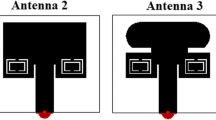Abstract
Metamaterial loaded star-shaped dielectric resonator antenna (SDRA) fed by aperture-coupled mechanism is used for the enhancement of bandwidth and gain. The star-shaped structure is made-up using biodegradable poly-lactic acid having a dielectric constant (εr) of 3.45 and loss tangent (tan δ) of 0.05, which adopt the cost-effective manufacturing i.e. additive manufacturing technique. The alteration in rectangular dielectric resonator antenna to make SDRA is the foundation for broad bandwidth while hybrid exciting-modes are due to feeding of two apertures (slots) of unequal length. Correspondingly, metamaterial i.e. an arrangement of the split-ring resonators have been used for gain enhancement of antenna. The enhanced peak gain of the metamaterial loaded SDRA is more than 12 dBi and the average radiating efficiency is ~ 81%. The proposed antenna attained a broad bandwidth of 41.1% ranging from 4.15 to 6.3 GHz which is suitable for the IEEE 802.11 WLAN standards and C-band wireless communications. The proposed antenna has also offer circularly polarized characteristics at 6 GHz. Thus such an antenna with a trait of circular polarization can be promising for other wireless applications.

















Similar content being viewed by others
References
Kshetrimayum, R. S. (2004). A brief intro to metamaterials. IEEE Potentials, 23(5), 44–46.
Smith, D. R., Padilla, W. J., Vier, D. C., Nemat-Nasser, S. C., & Schultz, S. (2000). Composite medium with simultaneously negative permeability and permittivity. Physical Review Letters, 84(18), 4184.
Ziolkowski, R. W. (2006). Metamaterial-based antennas: Research and developments. IEICE Transactions on Electronics, 89(9), 1267–1275.
Ziolkowski, R. W., Jin, P., & Lin, C.-C. (2010). Metamaterial-inspired engineering of antennas. Proceedings of the IEEE, 99(10), 1720–1731.
Dong, Y., & Itoh, T. (2012). Metamaterial-based antennas. Proceedings of the IEEE, 100(7), 2271–2285.
Werner, D. H. (2013). Transformation electromagnetics and metamaterials. Edited by Do-Hoon Kwon. London: Springer.
Jahani, S., & Jacob, Z. (2016). All-dielectric metamaterials. Nature Nanotechnology, 11(1), 23.
Hasan, M. M., Faruque, M. R. I., & Islam, M. T. (2018). Dual band metamaterial antenna for LTE/bluetooth/WiMAX system. Scientific Reports, 8(1), 1–17.
Sahu, B., Tripathi, P., Singh, R., & Singh, S. P. (2014). Dual segment rectangular dielectric resonator antenna with metamaterial for improvement of bandwidth and gain. International Journal of RF and Microwave Computer-Aided Engineering, 24(6), 646–655.
Li, J., Zeng, Q., Liu, R., & Denidni, T. A. (2017). Beam-tilting antenna with negative refractive index metamaterial loading. IEEE Antennas and Wireless Propagation Letters, 16, 2030–2033.
Zainud-Deen, S., Helmy, M. M., Badawy, H. A., & Malhat, El.-Azem. (2019). Dielectric resonator antenna loaded with reconfigurable plasma metamaterial polarization converter. Plasmonics, 14(6), 1321–1328.
Kumar, J., & Gupta, N. (2015). Bandwidth and gain enhancement technique for Gammadion cross dielectric resonator antenna. Wireless Personal Communications, 85(4), 2309–2317.
Keyrouz, S., & Caratelli, D. (2016). Dielectric resonator antennas: Basic concepts, design guidelines, and recent developments at millimeter-wave frequencies. International Journal of Antennas and Propagation, pp. 1–20, Article ID 6075680.
Kumar, P., Kumar, J., Singh, S., & Dwari, S. (2019). Design and investigation of dual band CDRA excited by conformal feed for broadband wireless applications. Wireless Personal Communications, 106(3), 1531–1546.
Kumar, P., Dwari, S., Mandal, M. K., Singh, S., Kumar, J., & Kumar, A. (2020). Electronically controlled beam steerable dual band star-shape DRA for UAS and Wi-Fi data link applications. IEEE Transactions on Antennas and Propagation. https://doi.org/10.1109/TAP.2020.2980358.
Srivastava, K., Kumar, A., Chaudhary, P., Kanaujia, B. K., Dwari, S., Verma, A. K., et al. (2018). Wideband and high-gain circularly polarised microstrip antenna design using sandwiched metasurfaces and partially reflecting surface. IET Microwaves, Antennas and Propagation, 13(3), 305–312.
Wiener, O. (1910). Zur theorie der refraktionskonstanten. Berichteüber Verhandlungen Königlich-Sächsischen Gesellschaft Wisseschaften Leipzig, pp. 256–277.
Acknowledgements
Authors would like to acknowledge Dr. S.V.A.V. Prasad from Lingaya’s University, Faridabad, India for technical discussion and Mr. Utkarsh, Director, Muwave Components Research and Development Pvt. Ltd., Ghaziabad, India for providing fabrication facility.
Author information
Authors and Affiliations
Corresponding author
Additional information
Publisher's Note
Springer Nature remains neutral with regard to jurisdictional claims in published maps and institutional affiliations.
Rights and permissions
About this article
Cite this article
Kumar, A., Kapoor, P., Kumar, P. et al. Design and Development of Enhanced Gain Aperture Coupled Broadband Biodegradable Dielectric Resonator Antenna for WLAN Applications. Wireless Pers Commun 115, 1525–1539 (2020). https://doi.org/10.1007/s11277-020-07641-3
Published:
Issue Date:
DOI: https://doi.org/10.1007/s11277-020-07641-3




